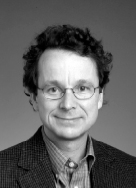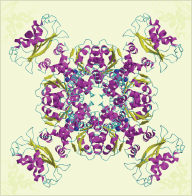PDF Version [93 KB]


THE NATIONAL INSTITUTE OF GENERAL MEDICAL SCIENCES (NIGMS) could be considered a “Nobel Prize Institute” because of its strong track record of funding scientists who receive this high honor. These investigators perform cutting-edge basic research that is the foundation for understanding normal life processes and disease. Nobel Prizes and other awards recognize the breadth and significance of these findings.
To date, NIGMS has funded the Nobel Prize-winning work of 67 scientists. Among their discoveries:
- Translating the genetic code of DNA and explaining how it functions in the production of protein in the cell.
Robert W. Holley and H. Gobind Khorana (shared with Marshall W. Nirenberg)
- Defining the internal organization of cells using electron microscopy and other techniques, which laid the foundation for understanding key cellular pathways and processes.
George E. Palade and Christian de Duve (shared with Albert Claude)
- Finding that RNA can act as a catalyst, controlling and directing cellular functions.
Thomas Cech and Sidney Altman
- Discovering restriction enzymes, which cut DNA at precise locations and are a cornerstone of recombinant DNA technology.
Hamilton O. Smith and Daniel Nathans (shared with Werner Arber)
- Identifying proteins that trigger a cell’s response to outside signals and are involved in normal activities as well as diseases like cancer, cholera, and diabetes.
Alfred G. Gilman (shared with Martin Rodbell)
These and other important breakthroughs in chemistry and biology often lead to more focused research that culminates years later in important medical advances or commercial products such as medicines or biotechnology tools.
RECENT NOBEL LAUREATES SUPPORTED BY NIGMS
| NAME |
NOBEL PRIZE |
OFFICIAL CITATION |
Osamu Shimomura,
Martin Chalfie, &
Roger Y. Tsien |
Chemistry 2008 |
For the discovery and development of the green fluorescent protein, GFP |
Mario R. Capecchi &
Oliver Smithies |
Physiology or Medicine 2007 |
For the discovery of principles for introducing specific gene modifications in mice by the use of embryonic stem cells |
| Roger D. Kornberg |
Chemistry 2006 |
For his studies of the molecular basis of eukaryotic transcription |
Andrew Z. Fire &
Craig C. Mello |
Physiology or Medicine 2006 |
For the discovery of RNA interference—gene silencing by double-stranded RNA |
| Robert H. Grubbs & Richard R. Schrock |
Chemistry 2005 |
For the development of the metathesis method in organic synthesis [a chemical reaction for making carbon-carbon bonds] |
Avram Hershko &
Irwin Rose |
Chemistry 2004 |
For the discovery of ubiquitin-mediated protein degradation |
| Paul C. Lauterbur |
Physiology or Medicine 2003 |
For discoveries concerning magnetic resonance imaging |
| Roderick MacKinnon |
Chemistry 2003 |
For discoveries concerning channels in cell membranes [specifically, for structural and mechanistic studies of ion channels] |
| H. Robert Horvitz |
Physiology or Medicine 2002 |
For discoveries concerning genetic regulation of organ development and programmed cell death |
| John B. Fenn |
Chemistry 2002 |
For the development of methods for identification and structure analyses of biological macromolecules [specifically, for techniques in mass spectrometry] |
| Leland H. Hartwell |
Physiology or Medicine 2001 |
For discoveries of key regulators of the cell cycle |
| K. Barry Sharpless |
Chemistry 2001 |
For work on chirally catalyzed oxidation reactions [a technique to selectively control the outcome of chemical reactions] |
| A full list of NIGMS-supported Nobel Prize winners is available at http://www.nigms.nih.gov/GMNobelists.htm |
FEATURED NOBELIST
Roderick MacKinnon, Rockefeller University

 Cells don't let just anything slip past their external membranes. Instead, protein channels control the passage of most substances, including the ions that allow nerves to signal, muscles to flex, and hormones to be secreted in an orderly way. For more than a century, chemists have understood that the flow of ions across membranes could produce electrical signals. But exactly how ion channels work has only been known since 1998, when Roderick MacKinnon showed for the first time what these proteins look like at the atomic level. This was such a fundamental achievement that he won a Nobel Prize in chemistry for it just 5 years later.
Cells don't let just anything slip past their external membranes. Instead, protein channels control the passage of most substances, including the ions that allow nerves to signal, muscles to flex, and hormones to be secreted in an orderly way. For more than a century, chemists have understood that the flow of ions across membranes could produce electrical signals. But exactly how ion channels work has only been known since 1998, when Roderick MacKinnon showed for the first time what these proteins look like at the atomic level. This was such a fundamental achievement that he won a Nobel Prize in chemistry for it just 5 years later.
"The role of channels in the body is so critical that we would not be alive were it not for the vigilance of these gateways in maintaining healthy cells. NIH-supported research in this area will no doubt continue to deepen understanding of the molecular roots of disease as well as fuel the discovery of new medicines to treat a wide variety of health disorders."
—Elias A. Zerhouni, Director, National Institutes of Health
NOBEL QUICK FACTS
The Nobel Prize was created by Swedish inventor Alfred Nobel. The international award has been given yearly since 1901 for achievements in physics, chemistry, physiology or medicine, literature, and peace. Another category, economics, was added by the Nobel Foundation in 1968.Winners receive their awards on December 10, the anniversary of Nobel's death. For more facts about the Nobel Prize, visit http://nobelprize.org/nobel_prizes/nobelprize_facts.html.
MORE INFORMATION
Want to know more about NIGMS and the award-winning researchers it funds? Visit http://www.nigms.nih.gov.
Content created September 2006; revised October 2008
NIGMS (http://www.nigms.nih.gov), a component of the National Institutes of Health in the U.S. Department of Health and Human Services, supports basic biomedical research that is the foundation for advances in disease diagnosis, treatment, and prevention.
